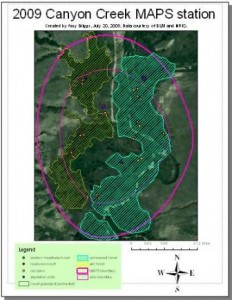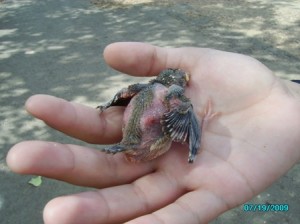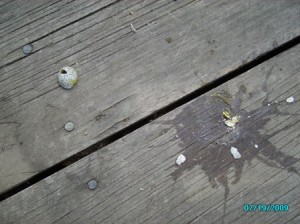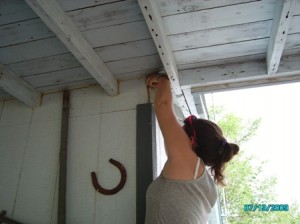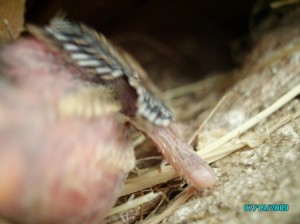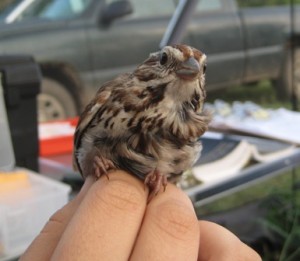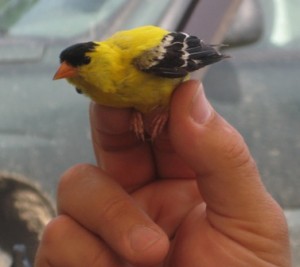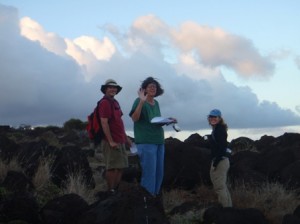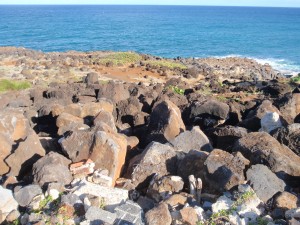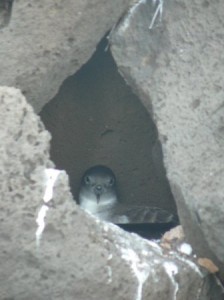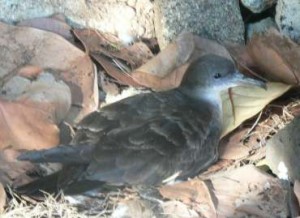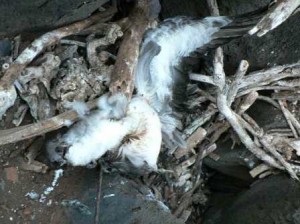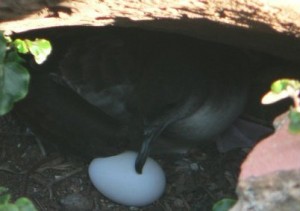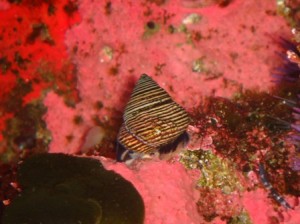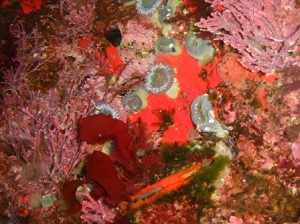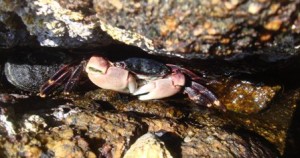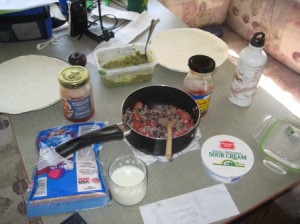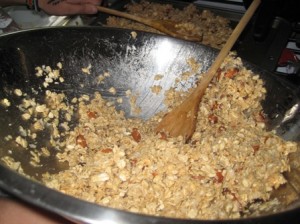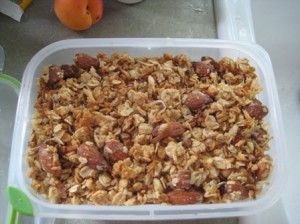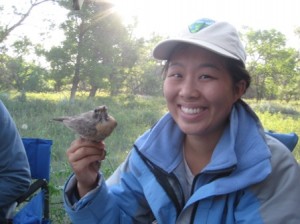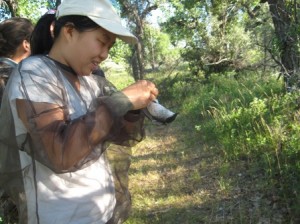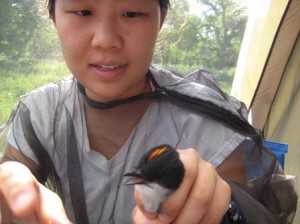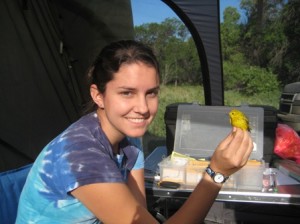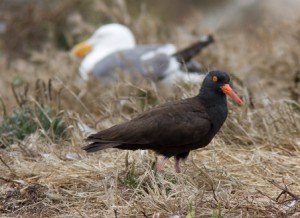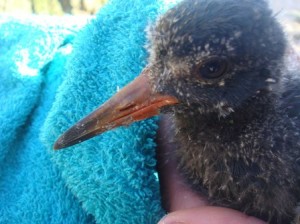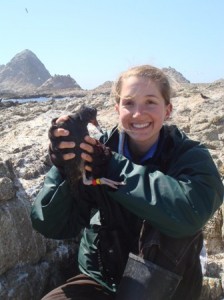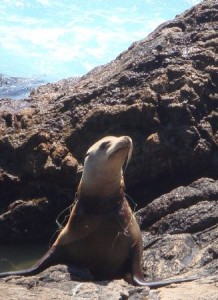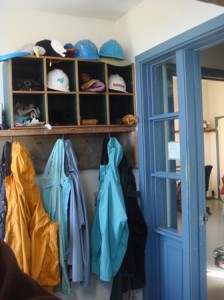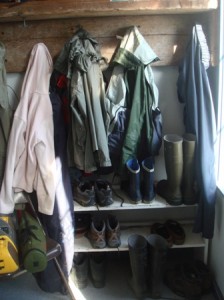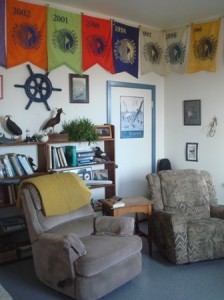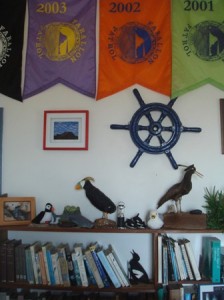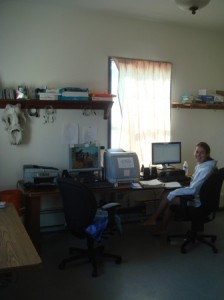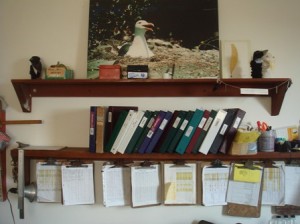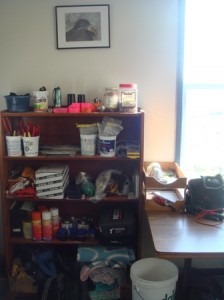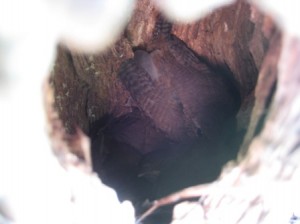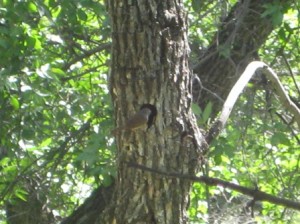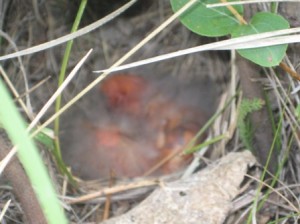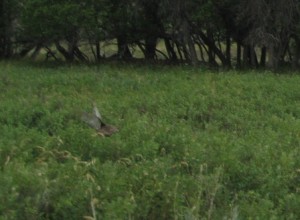Charlotte and I have once again taken up our posts in the BLM office because we had no field work planned for today. This is the slightly less glamorous part of our work here, but more comfortable on hot days (yesterday was a scorcher, and I think the AC in our trailer might have broken…) and still satisfying, especially when we complete things. I am the sort of person who loves checking things off my to-do list. Today, for example, we have already had several small victories: we entered all the data from our banding on friday into excel (check), got it uploaded into bandit, a national banding database (check), updated our bird species list (check), and I finished the MAPS station map I’ve been working on for the past week or two (CHECK!). As I put the finishing touches on this map, I was comparing it to sabrinas from two years ago and noticed that she finished her map on exactly the same day two years ago. Eerie.
Back in the office
Posted by: amy-briggs | July 20, 2009 | No Comment |which would you choose: a parasite or an invasive?
Posted by: amy-briggs | July 19, 2009 | 1 Comment |Earlier today, while I was sitting on the porch of the shady rest office, I noticed a little bird rolling around on the other end of the porch, looking very helpless and lost indeed. I walked over to check it out, and next to the bird was a splatter of yolk and albumin and some broken shell.
I consulted with charlotte, and we thought maybe it was a baby cowbird, because of the broken egg with it on the ground. cowbirds are nest parasites; the parents lay their eggs in other birds’ nests and the eggs hatch earlier that the resident’s eggs. when the cowbird egg hatches, the chick pushes the rest of the eggs in the nest out to get rid of the competition, and the nest parents raise and feed the cowbird. perhaps this little chick fell out of the nest while it was pushing the egg out? i had a strong suspicion that the nest it was in was a house sparrow nest, because there is a pair of house sparrows that hangs out in the area where we found the chick. house sparrows are an invasive species that comes from europe, and in rural/agricultural areas they outcompete native birds for cavities to nest in. we looked around a little and found the nest. we then had to decide: should we put it back? i thought we should put it back regardless of what species it was, but charlotte thought that if it was a house sparrow chick we should just leave it in some grass to get eaten by a cat, because house sparrows are invasive. in any case, she thought it was a cowbird, so we put it back. this chick will presumably keep pushing the sparrow eggs out, so i guess in the end we chose parasite over invasive.
I later googled image searched house sparrow and cowbird chicks, and I think it was probably a house sparrow chick because it had big yellow gape protuberances. oh well.
a face only a mother could love
Posted by: charlotte-chang | July 19, 2009 | No Comment |Last Friday morning (4:00 AM to be exact), Amy and I very sleepily headed out to our Canyon Creek banding station, with John taking the reins driving the pickup. All in all, we’ve had a very productive season, and that Friday was no exception; we banded a total of 18 birds, 14 of which we caught in our nets. We caught a few new species–a Song sparrow (present year-round at the BFS in Claremont), American goldfinches, and a Chipping sparrow. In fact, we haven’t even observed the Song or Chipping sparrows at our site until that day. The American goldfinches were a fun catch–four goldfinches had simultaneously flown into net 8 and formed a tight little square of bright yellow blobs in the two lower trammels.
We’re approaching the end of the breeding season, so we expect to see more and more hatch years (chicks born this calendar year) as the summer progresses. We’ve also had quite a few recaptures, which form the basis of survivorship estimates. The same brown thrasher continually gets caught at net 10, and we’ve had quite a few House wren recaptures.
Finally, four of the birds that we banded were the Western meadowlark nestlings that Amy and I have been monitoring through the season. These nestlings, like most bird chicks, are hideous; they are all awkward protruding joints, pin feathers, and bare skin. However, they do inspire quite the protective urge (as you’ll see in Amy’s post about our rescue of a potential House Sparrow/Brown-headed cowbird chick [I hope it’s a cowbird]) because they are so completely helpless, and try to use their nubs of wings to cover their heads. They are simultaneously ugly, pathetic, and adorable–in short, a face that only a mother (or a birder) could love.
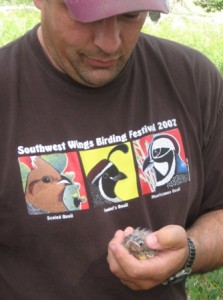
John holding a just-banded Western meadowlark chick. Note the pin feathers (the small feathery tufts sticking out of prominent shafts).
It’ll be intriguing to study these little chicks’ survivorships. According to John Carlson, the first year is typically the hardest year overall for birds to survive. He cites the example of Emperor penguins in Antarctica–if nestlings manage to make it past the first year, then they can live to be 10+ years old, but the great challenge is getting through that first year. Hopefully they’ll make it, and with any luck, John and other students can recapture them in the future.
Wonderous Wedge-tailed Shearwaters
Posted by: nina-karnovsky | July 15, 2009 | 5 Comments |Aloha from Oahu!
I am here with my colleague David Hyrenbach from Hawaii Pacific University. We are in the formative stages of beginning a project with wedge-tailed shearwaters. Yesterday we went with Wendy Johnson from the Hawaii Audubon Society to the Freeman Seabird Reserve at Black Point.
Mr Freeman donated this land to preserve the area for the nesting wedge-tailed shearwaters. Historically these seabirds nested all along the Oahu coastline. Now this is one of the only places left where they nest on Oahu; most of the other known sites are small islets offshore.
We searched the boulder field for nesting birds. They like to either dig burrows or nest under boulders. We found some out in the open.
Most of the wedge-tailed shearwaters nest here but a few lucky residents in the neighborhood adjacent to the reserve have a few birds nesting in their yards! Unfortunately, living close to people means the birds are vulnerable to dogs, cats, and mowing. We found this bird that looked like it had been attacked by a cat.
We found some of the birds had eggs. They only lay one egg per year. Let’s hope for a successful nesting season!
The Hawaii Audubon Society has been working hard to restore the native vegetation to the site. If you are interested in volunteering or in making a donation to help the ‘Ua’u kani; contact them!
The Intertidal
Posted by: eleanor-caves | July 14, 2009 | 1 Comment |So, as if getting to go down to Mussel Flat yesterday chasing after Oystercatchers wasn’t enough of a treat, today we all took a field trip down to Jewel Cave, on the East end of the island, during low tide, to go tidepooling. All I can say is, the intertidal zone out here is absolutely another world, and the caves and coves down there were places I literally could have spent all day. There was so much to see that I’m going to make this post primarily pictures, rather than words, and hopefully convey a sense of what a dramatically different, colorful world those tidepools are.
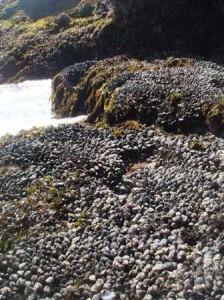
Large mussel beds coat the rocks at the entrances to many of these caves (can be tough on the shoes!)
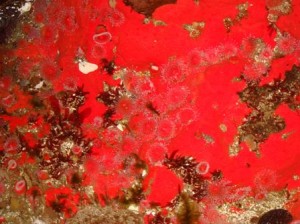
A colony of bright red anemones. These were common inside jewel cave, and they often came in large mats, giving huge swaths of color to the tidepools.
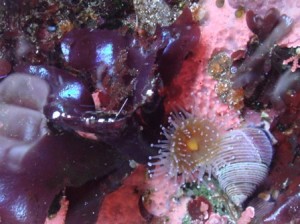
Snail, small anemone, and iridescent plant. This iridescent plant was found in all the tidepools we explored, emitting a beautiful blue color and light.
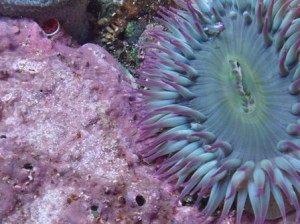
Anemone Close-Up. This is a different type of anemone than the bright ones from earlier. These purple-green ones were large, about the size of my open hand, and numerous.
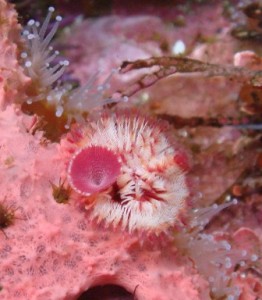
Tiny, delicate tube worm of some sort. When disturbed, this whole gill complex would retreat back into its tube with startling speed.
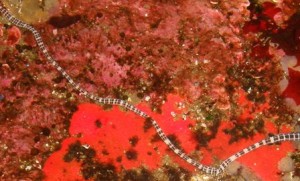
This is part of a really long worm I found. When we would touch one end, the whole thing would creep along, but there was no way I could get its whole body in one shot.
Well, there’s a brief overview of what I saw! Pretty neat. The field trip took up most of the morning, and the afternoon was taken up with my chick checks and elephant seal resights. Tonight we start our next round of rhino netting, so we’ll have nightwork again for the next four nights. That’s all for now!
Best,
Eleanor
To Paula Deen
Posted by: charlotte-chang | July 14, 2009 | 1 Comment |Since Amy’s arrival, I have been eating much better. I’m not the world’s best cook–far from it–but Amy is both creative and skilled at making some delicious meals. We’ve had curry (tasty), baked ziti (great), cheese pasta (fantastic), and home-made granola (amazing). Finally our stove and oven are getting some good use!
You may be asking, who’s Paula Deen? http://www.youtube.com/watch?v=aJZeG0aRlvQ
banding, etc.
Posted by: amy-briggs | July 14, 2009 | No Comment |Charlotte and I have been working hard and getting out to our study site almost every day. We went out banding two days ago, and caught lots of birds, including yellow warblers, robins, and brown thrashers. We also recaptured a male house wren that sabrina banded two years ago (exciting!). Here are some of the pictures we got from saturday:
Black Oystercatchers
Posted by: eleanor-caves | July 13, 2009 | 1 Comment |So, there is one species of bird breeding on the island that I’ve hardly said anything about–the Black Oystercatchers. This is partly because their breeding population here is small, partly because not much work is done with them, and partly because they are hard to get to. Black Oystercatchers nest right along the shore, and it’s hard for us to handle them without disturbing all of the seals and sealions that haul out along the rocky shoreline here.
There is, however, monitoring of the black oystercatchers that occurs–this year, it’s Hannah’s project. She watches them through a scope, noting how their chicks are growing and where their nests are. And, a couple of times in a breeding season, we crawl, on our hands and knees, out to their nest sites to band their chicks. Today, since I had a light workday, I got to go along.
Black Oystercatchers (BLOYs) are really cool birds. They have long orange bills, bright yellow/orange eyes, and weird stick-like, light-colored legs. They also make a really high pitched shrieking sound, almost a squeak, and their chicks are very cute.
BLOY chicks are banded when they appear to be almost fully feathered, meaning their flight feathers are almost all the way in. This way, they’re big enough to band, but not so developed that they’ll fly away when we try to catch them. As you can see here, at this stage, the chicks are starting to develop their orange coloration on the bill, but still have some downy patches around their body and face. They’re very calm as far as chicks go–they don’t twitch or try to break free, and so they’re not too difficult to band.
Banding the BLOY chicks was a ton of fun, and took most of the afternoon. We only ended up banding four (that’s actually a pretty high number, considering how few there are out here), but each banding took a really long time. This is because to band them, we had to go to places on the island that people don’t usually go during Seabird Season. I got to visit some places down by the water on the marine terrace that i’ve only seen from the lighthouse (It’s amazing to think about how many places on the island, despite its very small size, I will never see). As I mentioned earlier, we also had to get to these sites by literally crawling on our hands and knees, so as not to disturb the pinniped populations.
Banding the BLOY chicks managed to get me closer to the sea lions than I have been since I got here. The elephant seals I work with are abnormally calm around humans, but california sea lions, stellar’s sea lions, and harbor seals (outside of places like Pier 49) are actually really skittish creatures.
I got close enough to some sea lions to notice that this one, unfortunately, is a “ringneck,” meaning he’s gotten tangled in some sort of human-created line. We’ll note this in the journal tonight, but unfortunately, there’s not really anything we can do about it, and it’s very sad.
Other than banding BLOY chicks, I had a relaxed day, so I did laundry (for the second time since I got here), mended mistnets, and spend some time in the Sea Lion Cove blind watching Gray Whales.
Tonight, Meghan is going to show us pictures from her doctoral work in Russia, where she worked with Siberian Tigers. Should be really neat!
Best,
Eleanor
The House, Part 1
Posted by: eleanor-caves | July 12, 2009 | No Comment |Well, today was Sunday, which means two things. One: brunch day!! Brunch day is a great day here on the Farallones, taken very seriously. Today, Hannah made homemade cinnamon rolls (seriously delicious), and the rest of us worked collectively on breakfast tacos (homefried potatoes, scrambled eggs, bell peppers, corn tortillas) and fruit smoothies (pineapple banana strawberry). It was amazing. The second thing Sunday means is that I now have less than three weeks remaining on the island, which I absolutely cannot believe. So, figuring that I’ve lived in the same house for five weeks now, I decided it was time to put up some pictures of the house.
The first thing to understand about this house is that it has been around a long time. It has seen a lot of people, a lot of things, and a lot of events. It has collected things, things left behind on purpose or not, or things brought out here with the sole intention of leaving them in the house, for a very long time. It is a veritable treasure trove of odd things, and I still don’t know where everything is, and probably never will. But, for starters, we’ll start with several key downstairs rooms.
The first room you come to when you enter the house is the Shoe Room. The Shoe Room is pretty simple, it’s exactly what it sounds like. If you take just a minute to think about all the things we must step on when walking around the island during the course of a day, it makes pretty good sense that no outside shoes are allowed in the house. Thus, the Shoe Room is where you change into your house shoes, take off your windbreaker, gloves, hat, sunglasses, hardhat, and anything else you might be wearing solely outdoors.
Everyone has at least two pairs of shoes out here (hiking boots and rubber boots), as well as a couple of jackets, so the shoe room gets pretty full.
As you can imagine, it also gets pretty smelly. It is one of the weekly chores (which are done every Saturday) to clean out the Shoe Room, but it never really stays clean for more than, oh, twenty minutes. It also takes on a very special odor, different every week, which can get pretty ripe by the end of the week.
No matter how gross it gets though, the Shoe Room is probably the second most necessary room in the house (behind the kitchen, of course).
When you walk through the door, out of the shoeroom and into the house, there is a hallway, and you can go either up the stairs, left to the living room, or right to the computer room.
The Living Room is pretty much what any living room in any house is: the room with comfy chairs, a comfy couch, and a couple of nice windows. It’s where we go to read, and where Russ’ computer lives.
We don’t often all congregate in the living room, unless it’s been a really easy workday and everyone is back early, with nothing to do before dinner. Sometimes, if someone is running late on dinner, we’ll all find ourselves in the Living Room, reading or chatting or whatnot.
The flags you can see all over the walls in the Living Room are for the Farallon Patrol, the volunteer group of skippers and boat captains that makes up the majority of the transport to and from the island. (Whoever designed the flag needed some serious advice on color matching during a few choice years, but whatever.) The Living Room is also where our weather station is, which I pictured in an earlier entry.
Finally, what sets this Living Room apart from other Living Rooms everywhere are the decorations. As you can see in this photo, there are a lot of bird things everywhere, and some of these birds and real, stuffed birds, and some are not. They’ve been decorated, banded, given hats, or whatever. They’re very cute. The Living Room is also where most of the island’s records are kept, most importantly the old journals (I still have to write about the journal…will do in a few days). Journals are kept every single night, right after dinner, and it’s really fun to read journals from 30 years ago, discovering what was the same about island life then and what was different.
The last room I’ll talk about today is the Computer Room. The Computer Room holds a lot of the most important things in the house. To begin with, it has our two house computers, where all of our data entry takes place. Every day, the six of us collect a LOT of data–chick weights, chick feathering status, diet watch information, band numbers for newly banded birds, band numbers from resighted birds, band numbers from dead birds, information in general about dead birds, attendance of various bird species at their nesting sites, pinniped census data, you name it. We are each in charge of data entry for a few different studies, and it’s important to keep on top of it, or it overwhelms you.
All data is entered on the computer and immediately backed up to an external harddrive and a thumb drive. Once all the data for a study is completed, it is proofed, meaning Pete/Russ and whoever entered the data go back through it ALL, making sure what’s in the computer lines up with what is in the field notebooks and binders.
The Computer Room is also where we keep all of our experimental protocols (in the binders on the shelf), field data notebooks (a box of yellow notebooks next to the binders; these notebooks are on a very special type of paper that can take a lot of abuse–weather, guano, whatever), and census data clipboards. Everything on this wall is incredibly important. The experimental protocols often have to be consulted a few times during the course of a study, because the details that have been hammered out over the years can be really difficult to keep straight when you’re working on ten studies at the same time.
Finally, the Computer Room is where you can pick up all the supplies you might need before you go outside to do a study. Almost everything that is necessary for the studies is on this shelf–headlamps and flashlights (for looking in crevices and working in the Habitat Sculpture), banding pliers of many shapes and sizes, bands of many shapes and sizes, spray paint (for painting chicks, which we do to tell them apart from their siblings and the chicks of neighboring nests), industrial glue (for putting on colorbands), weighing bags and scales, whirl paks (sterile little bags for collecting samples, most often diet samples), gull towels, and fanny packs (which you really need when you’re carrying around most of the other stuff on the shelf). We also use a bucket to weigh birds when it’s really windy, and collected bands from dead birds go in containers on this shelf. Phew! Lots of stuff packed in here.
Well, that’s a whirlwind tour of part of the downstairs. I’ll photograph the rest of the house bit by bit and hopefully get through it all. Tomorrow’s a very light workday for me, which is nice, since I had 7am diet watch this morning. During diet watch, we noticed that the gulch which we overlooked during the watch, had an apparent oil slick in it. We noted a Pacific Loon and a Western Gull swimming around the gulch who appeared to be oiled (it wasn’t a dark oil, so no dark blotches appeared on the birds; rather, they just looked slightly yellowed and very waterlogged, which is not characteristic of birds who are meant to spend so much time in the water). It’s unknown where the oil came from, most likely a passing ship, but we keep track of oiled animals on the island and do what we can.
Alright, that’s all for now! Dinner’s almost ready! Pete’s making homemade veggie burgers, elk steaks (provided by Meghan, whose friend shot the elk), veggie kabobs, and sweet potatoes, and we’re watching a movie during dinner. Seriously too much food.
Best,
Eleanor
little bitty birdies
Posted by: amy-briggs | July 10, 2009 | No Comment |As charlotte just mentioned in her post, we have been very busy doing veg surveys and some low tech bird censusing around our site. A few days ago we were strolling around in the Ash forest part of our site, near net 2, and we noticed a couple of house wrens getting very annoyed with us and making their funny “stay away” noise, which is a combination of a chirp and a rattle.
Charlotte though they were probably trying to scare us away from their nest, and so we started searching for it. What we found was an old dead ash trunk that looked like a house wren apartment complex! the one trunk had three nest-sized holes in it, but sadly two of them were too high up for us to get a good look into. however, the one that we could see into was chock full of little house wrens! these birds have pretty much full juvenile plumage, and will probably be leaving the nest soon, so we were glad to catch them while they were still there. at first glance, we only saw four birds, but when we returned today we counted five little beaks in this hole. Charlotte noticed the mother in a nearby tree with something in her beak, so we backed off and let her go back to the nest. we sat back and watched her feed these little guys for a good five minutes or so before continuing with our census.
House wrens are not the only birds breeding at our site. We also found a western meadowlark nest, which I posted photos of a few days ago. When charlotte and I returned to the nest yesterday, they had hatched! We went back again today and it was very cold, so these guys were huddling together for warmth and moving around, crawling on top of each other. Newly hatched birds are not the cutest things in the world, so I won’t put up the super close-up I have of these guys.
Charlotte also mentioned that we’ve been seeing a mother sharp tailed grouse with seven of her juveniles around our site. Before we saw them over the past week, we had only seen adult sharp tailed grouse, and they were always up on the prairie out of the coulees, so we were pumped to see them in our riparian corridor. These guys are very hard to catch on film, because they sit in the grass until you stumble upon them and then fly away very fast. I did manage to get this picture of them though:
Well, that’s all for now, folks. But stay tuned for more posts!

